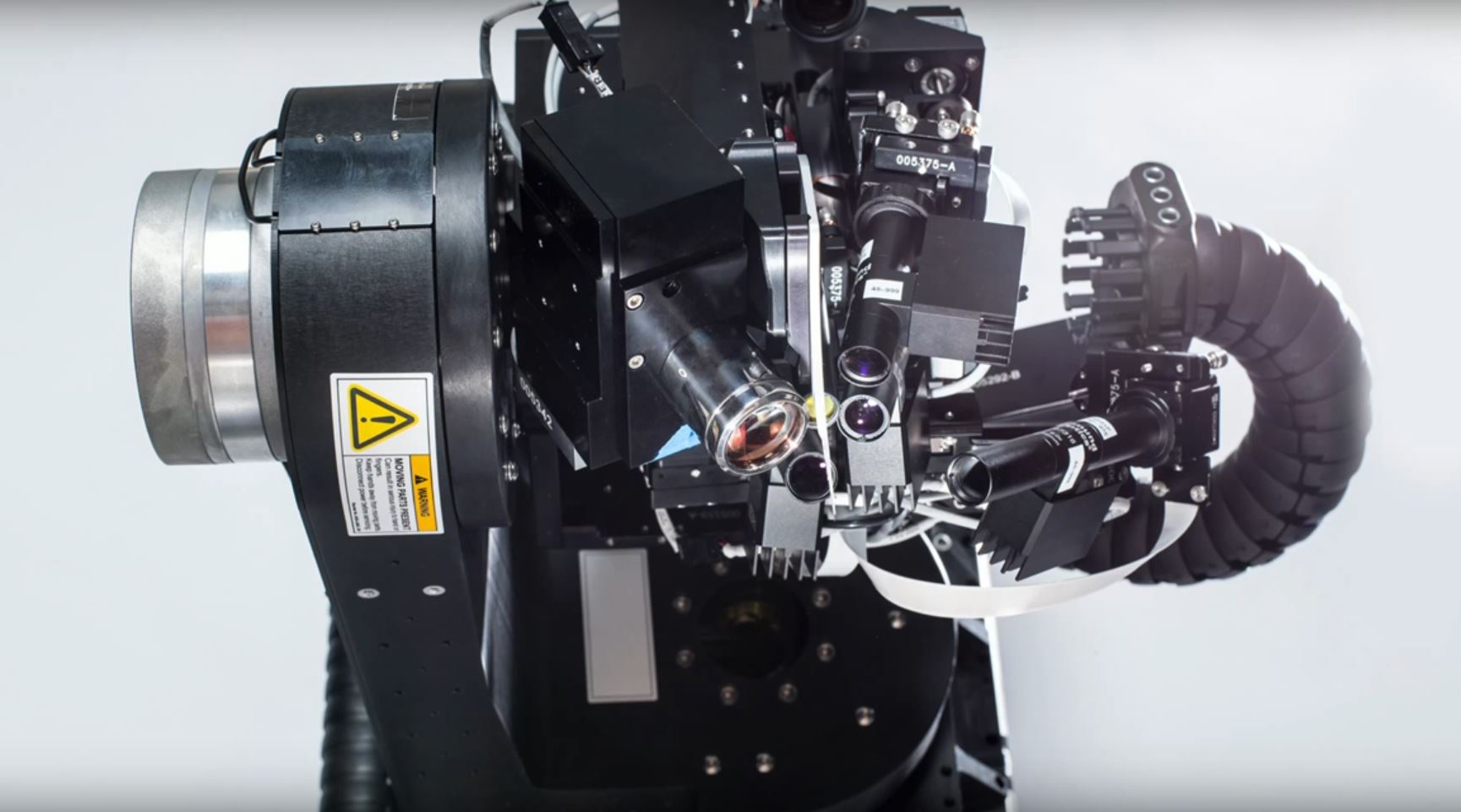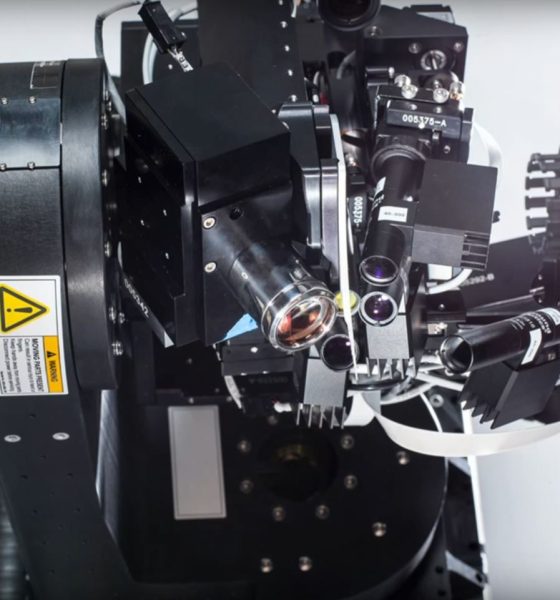

News
Elon Musk’s Neuralink brain-machine interface is turning sci-fi into reality
Besides giving the world the option to switch to Tesla emissions-free electric cars and hopes of sending humans to Mars and beyond, Elon Musk also dreams of giving humans symbiosis with artificial intelligence through an implantable brain-machine interface created by Neuralink, a company he founded in 2016.
Neuralink is working on improving the basic structures of high-density Utah Array, a tiny chip that has become the industry benchmark for recording large populations of neurons. Dr. Richard Norman from the University of Utah invented the chip in 1997, which acts as an ultra-thin, flexible, and biocompatible polymer that connects the human brain to a tiny chip. During an event last year, Neurallink explained that the implant can be placed behind the ear and can interpret brain signals. Musk’s neural tech company has also invented a robot that can sew the implant to the brain with better precision than any human surgeon.
Wait until you see the next version vs what was presented last year. It’s *awesome*.
— Elon Musk (@elonmusk) February 3, 2020
So far, the brain-machine interface by Neuralink has reportedly helped a primate communicate with a computer interface. There are plans to install a prototype this year into a human. According to Musk, they are still on track to do this.
“It will ultimately be used to make up for entire lost sections of the brain due to stroke/accident/congenital. Don’t want to get too excited, but the potential is truly transformational for restoring brain & motor functions. There is no other way to do it imo,” Musk also wrote on Twitter.
The possibilities for Neuralink’s implant are endless. The symbiosis between humans and AI will be a long shot but Neuralink’s implantable device can pave the way for medical advancements that can help people with chronic neurological problems. Possible medical uses for Neuralink’s device in the future include controlling devices, restoring sensation, and synthetic speech.
CONTROLLING DEVICES
The brain is a complex network of nerves that uses impulses to sense the outside world and to control the human body. Neuralink will use these signals and amplify them so a patient can use them to be more functional. For example, someone with paralyzed upper extremity due to a stroke can have a brain-machine interface on the center of the brain that controls movements of the arm and hands which will help patients feed, dress, and generally function on their own.
Likewise, for someone who has an amputated limb, the Neuralink brain-machine interface will be able to communicate with a robotic arm to help someone use an artificial hand to write or use a computer. It can also be perfect for someone who needs to control a robotic leg to prop one up to stand without the help of anyone.
With a smart home setup, a paralyzed person who cannot clearly or is unable to speak and move can simply command a computer to dim the lights, turn on the air conditioner, or call someone if they need urgent attention.
While it might be a very long shot, these brain-machine interfaces interacting with other future technologies can also serve as bridges to parts of the body that are medically “disconnected”. For example, a patient with spinal cord injury has severed connections between the brain and parts of their body corresponding to the level their spinal cord was injured. The Neuralink implant can play pseudo stem cells that will provide the artificial connection so one can better function. Same for someone with multiple sclerosis whose nerves basically lose the sheath that makes them transmit electrical signals optimally.
“RESTORE” SENSATION
Just like how Neuralink can be exploited to help the brain control movement of a robotic arm, it is highly possible to tap into the sensory cortex of the brain. Sensation allows better manipulation of one’s environment and should be very helpful even when using robotic arms. One can tap the signals of the brain, send it to the brain-machine implant and to the robotic hand, for example, and back. If one grabs a glass of water, it can easily control the movement through space because the patient knows its shape, weight, texture, temperature, among other factors.
The Neuralink team also aims to use the brain-machine interface to “give back” one’s vision by tapping into the visual center of the brain.
SYNTHETIC SPEECH
With its ability to tap into specific signals of the brain, Neuralink also has the potential to create synthetic speech for people who are paralyzed or those with neurological conditions that do not allow them to speak.
These are just some of the things we can see Neuralink will be used for in the future. While all these seem to be fantastical, according to Neuralink, what they’re doing is not pulled from thin air but based on decades of neurological foundation.
Ultimately, with the dream of human-AI symbiosis, as more technologies develop, the use for Neuralink’s brain-machine implant will evolve. Elon Musk mentioned before that perhaps one day, it will be used for telepathic communication between humans or perhaps even drive a Tesla. Or perhaps, in the future, one can upgrade one’s knowledge and download terabytes of information with a blink of an eye through Starlink.

News
Tesla FSD fleet is nearing 7 billion total miles, including 2.5 billion city miles
As can be seen on Tesla’s official FSD webpage, vehicles equipped with the system have now navigated over 6.99 billion miles.

Tesla’s Full Self-Driving (Supervised) fleet is closing in on almost 7 billion total miles driven, as per data posted by the company on its official FSD webpage.
These figures hint at the massive scale of data fueling Tesla’s rapid FSD improvements, which have been quite notable as of late.
FSD mileage milestones
As can be seen on Tesla’s official FSD webpage, vehicles equipped with the system have now navigated over 6.99 billion miles. Tesla owner and avid FSD tester Whole Mars Catalog also shared a screenshot indicating that from the nearly 7 billion miles traveled by the FSD fleet, more than 2.5 billion miles were driven inside cities.
City miles are particularly valuable for complex urban scenarios like unprotected turns, pedestrian interactions, and traffic lights. This is also the difference-maker for FSD, as only complex solutions, such as Waymo’s self-driving taxis, operate similarly on inner-city streets. And even then, incidents such as the San Francisco blackouts have proven challenging for sensor-rich vehicles like Waymos.
Tesla’s data edge
Tesla has a number of advantages in the autonomous vehicle sector, one of which is the size of its fleet and the number of vehicles training FSD on real-world roads. Tesla’s nearly 7 billion FSD miles then allow the company to roll out updates that make its vehicles behave like they are being driven by experienced drivers, even if they are operating on their own.
So notable are Tesla’s improvements to FSD that NVIDIA Director of Robotics Jim Fan, after experiencing FSD v14, noted that the system is the first AI that passes what he described as a “Physical Turing Test.”
“Despite knowing exactly how robot learning works, I still find it magical watching the steering wheel turn by itself. First it feels surreal, next it becomes routine. Then, like the smartphone, taking it away actively hurts. This is how humanity gets rewired and glued to god-like technologies,” Fan wrote in a post on X.
News
Tesla starts showing how FSD will change lives in Europe
Local officials tested the system on narrow country roads and were impressed by FSD’s smooth, human-like driving, with some calling the service a game-changer for everyday life in areas that are far from urban centers.

Tesla has launched Europe’s first public shuttle service using Full Self-Driving (Supervised) in the rural Eifelkreis Bitburg-Prüm region of Germany, demonstrating how the technology can restore independence and mobility for people who struggle with limited transport options.
Local officials tested the system on narrow country roads and were impressed by FSD’s smooth, human-like driving, with some calling the service a game-changer for everyday life in areas that are far from urban centers.
Officials see real impact on rural residents
Arzfeld Mayor Johannes Kuhl and District Administrator Andreas Kruppert personally tested the Tesla shuttle service. This allowed them to see just how well FSD navigated winding lanes and rural roads confidently. Kruppert said, “Autonomous driving sounds like science fiction to many, but we simply see here that it works totally well in rural regions too.” Kuhl, for his part, also noted that FSD “feels like a very experienced driver.”
The pilot complements the area’s “Citizen Bus” program, which provides on-demand rides for elderly residents who can no longer drive themselves. Tesla Europe shared a video of a demonstration of the service, highlighting how FSD gives people their freedom back, even in places where public transport is not as prevalent.
What the Ministry for Economic Affairs and Transport says
Rhineland-Palatinate’s Minister Daniela Schmitt supported the project, praising the collaboration that made this “first of its kind in Europe” possible. As per the ministry, the rural rollout for the service shows FSD’s potential beyond major cities, and it delivers tangible benefits like grocery runs, doctor visits, and social connections for isolated residents.
“Reliable and flexible mobility is especially vital in rural areas. With the launch of a shuttle service using self-driving vehicles (FSD supervised) by Tesla in the Eifelkreis Bitburg-Prüm, an innovative pilot project is now getting underway that complements local community bus services. It is the first project of its kind in Europe.
“The result is a real gain for rural mobility: greater accessibility, more flexibility and tangible benefits for everyday life. A strong signal for innovation, cooperation and future-oriented mobility beyond urban centers,” the ministry wrote in a LinkedIn post.
News
Tesla China quietly posts Robotaxi-related job listing
Tesla China is currently seeking a Low Voltage Electrical Engineer to work on circuit board design for the company’s autonomous vehicles.

Tesla has posted a new job listing in Shanghai explicitly tied to its Robotaxi program, fueling speculation that the company is preparing to launch its dedicated autonomous ride-hailing service in China.
As noted in the listing, Tesla China is currently seeking a Low Voltage Electrical Engineer to work on circuit board design for the company’s autonomous vehicles.
Robotaxi-specific role
The listing, which was shared on social media platform X by industry watcher @tslaming, suggested that Tesla China is looking to fill the role urgently. The job listing itself specifically mentions that the person hired for the role will be working on the Low Voltage Hardware team, which would design the circuit boards that would serve as the nervous system of the Robotaxi.
Key tasks for the role, as indicated in the job listing, include collaboration with PCB layout, firmware, mechanical, program management, and validation teams, among other responsibilities. The role is based in Shanghai.
China Robotaxi launch
China represents a massive potential market for robotaxis, with its dense urban centers and supportive policies in select cities. Tesla has limited permission to roll out FSD in the country, though despite this, its vehicles have been hailed as among the best in the market when it comes to autonomous features. So far, at least, it appears that China supports Tesla’s FSD and Robotaxi rollout.
This was hinted at in November, when Tesla brought the Cybercab to the 8th China International Import Expo (CIIE) in Shanghai, marking the first time that the autonomous two-seater was brought to the Asia-Pacific region. The vehicle, despite not having a release date in China, received a significant amount of interest among the event’s attendees.








